On January 1, 1959, Alaska became the 49th state in the United States of America. Joining dozens of other businesses, Louis Marx manufactured several products that were intended to take financial advantage of the event, releasing four playsets in 1958 and 1959 related to Alaska and the Arctic.
The playset that qualifies the figures and accessories below as a part of the Wild West is a set that featured the Alaskan frontier gold rush at the end of the 19th Century. In fact, the set was initially titled the Alaska Frontier Play Set, but by the time the set hit the market, the name had been changed to simply the Alaska Play Set (#3708). This was the fourth and final of the Alaskan sets and was an excellent example of Marx' economy in re-using existing molds: the set included the existing 54mm miners and trappers (see Page 3), Eskimos and accessories included in previous Alaskan playsets, and a Wild West townfront re-lithographed to match the Alaska environment.
Marx' other three playsets related to Alaska and the Arctic in 1958 and 1959 were
Of course, among collectors today such requirements are a moot point. We demand no such "playability" and instead are entranced with the sets' miniature dog sleds, howling wolves, frosty plastic igloos, and spear-fishing Eskimos.
I will admit that including Eskimos as a Wild West theme may seem a bit strange at first thought, but Eskimos were native American inhabitants. And that means they were Indians, though not quite the style of Indian that generally comes to one's mind regarding the Wild West. Also, Alaska is definitely in the western part of the United States. And there was a wild gold rush in Alaska during the final years of the 1890s, similar to the California gold rush 50 years earlier, that brought hundreds of rough and tough Americans to the frigid Arctic seeking that elusive yellow rock. Even Wyatt Earp and some of his friends from Tombstone spent a few years in Alaska! So it seems logical to me that these figures should be included here.
The thought to include these figures on this web site did not strike me until mid-2009, and even then I delayed creating this page until I obtained a reasonable number of the playset figures and accessories. I finally reached that goal at the 2011 West Coaster when I purchased the final figures in the Eskimo group from veteran seller Tom Sturgeon (teestoys@aol.com) and a complete set of Mexican-made re-issue accessories from Willie and Rosa of Forester Enterprises (www.willieandrosasclassicsoldiertoybox.com). These re-issues are in a dull silver color and what I would call a somewhat soft hard plastic (or perhaps a hard soft plastic); I hope that I can replace them with originals soon.
Because the Eskimo figure group, the Arctic animal group, and the Arctic accessories are included only in this one Wild West playset, I have chosen to show them on this separate page, as well as detail the complete contents of the Alaska Play Set. As noted in the text below, the Miner and Trapper figure group and the Stockade Outdoor Accessory Group are included in many Wild West playsets and are shown elsewhere in the Wild West section of this web site.
Articles on the Alaska Play Set are in PFPC Issue 4 and Playset Magazine Issue 51. The PFPC article also includes information on the Arctic Explorer set. The D.E.W. and I.G.Y. sets are featured in Playset Magazine Issue 32.
Eskimos
PL-912
Unlike, other Marx Wild West figure groups, this group of 54mm figures is made up of people going about their daily business in a fairly peaceable manner. Many of the 16 Eskimos (11 poses) are hunting or fishing, but none are shooting, clubbing, knifing, or involved in any other violent action. This may have contributed to the fact that the Alaska set was not a big seller and was in production for only in 1959. Similar to the kids of today, we kids of the 1950s and 1960s liked our playsets to be action-packed and extreme. This same group of figures was in the company's other three Alaska and Arctic sets.
The Alaska set included two figures of Poses 7 through 11 and one figure of all other poses. They were blue soft plastic in this set, but Playset Magazine reports that the I.G.Y. sets had yellow Eskimos. Therefore, I assume the yellow ones shown below came from an I.G.Y. set or perhaps in bagged sets of figures; I have included them in yellow just to add a little variety to the page.
Figures such as the "pulling dead seal" and "spear fishing" are difficult to find with unbroken ropes. Re-issues exist; the ones I have seen are easy to distinguish from the originals. My personal favorite has to be the fellow rowing his kayak, but only because I've always wanted to give that a try.

54mm Miners and Trappers
PL-1014
The factor that confirms the Alaskan Play Set belongs to the Wild West category is the presence of the 54mm Miner and Trapper figure group. This group of figures (see larger photos on Page 3 of the Wild West Section) was used in a large number of Wild West playsets, including Roy Rogers, Gunsmoke, and Johnny Ringo. Marx created this group for its gold mine theme playsets, but eventually combined it with its 54mm cowboy figures in a huge 32-figure group. The mold was slightly revised even before that, as the "holding fur" pose (Pose 11 below) was replaced by a new miner figure for most Wild West sets. For the most part, these figures were produced either in gray or butterscotch. The group in the Alaska set was a gray soft plastic and included the 12 poses shown below with duplicates of Poses 3, 4, 5, and 6.
As noted on the 54mm figure page (Page 3), these figures are nicely detailed, and the group includes a good variety of poses involved in mining or trapping activities. Because the "holding fur" pose (Pose 11) was replaced in most Wild West sets, it is the most difficult pose to find. In fact, this pose in the gray color is unique to the Alaska set. Also, note that the tiny bag for the Pose 2 figure is virtually impossible to find today, as its size caused it to be quickly lost by us kids back in the late 1950s. The figure with an original bag (I have not seen the bag re-issued) should set you back $50 to $100, or perhaps even more.
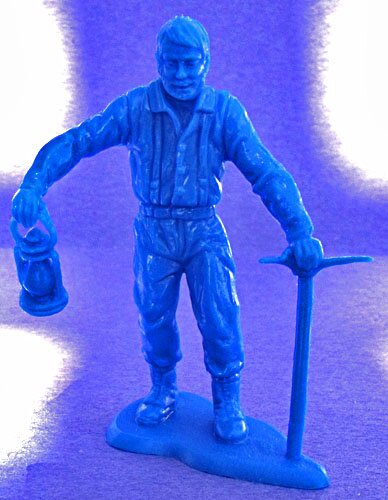 Marx' other three Alaska and Arctic playsets did not inlcude this group of figures. Instead, they had a group of 12 more modern Arctic figures that are commonly called the Arctic Explorers (including several U.S. military personnel). Like the Eskimos above, the Arctic Explorers appeared in no Marx playsets except the Alaska and Arctic sets. In general, these more modern figures would not fit in the Alaska gold rush theme, but the group does include a miner holding a lantern and pick that could easily have been added to the Miner and Trapper group (see photo at left).
Marx' other three Alaska and Arctic playsets did not inlcude this group of figures. Instead, they had a group of 12 more modern Arctic figures that are commonly called the Arctic Explorers (including several U.S. military personnel). Like the Eskimos above, the Arctic Explorers appeared in no Marx playsets except the Alaska and Arctic sets. In general, these more modern figures would not fit in the Alaska gold rush theme, but the group does include a miner holding a lantern and pick that could easily have been added to the Miner and Trapper group (see photo at left).
Other than the small bag and the "holding fur" pose, these figures are easy to find and inexpensive in today's market. Re-issues exist in large numbers.

Animals
PL-911
Eighteen animals in 9 poses came with the Alaska set. Playset Magazine states they came in cream soft plastic in the Alaska Play Set; PFPC says that the various Alaska sets included the animals in both cream and gray. Compared to the hefty horses and cattle of the usual Wild West playsets, these animals are almost disappointingly small and fragile. The baby penguins are particularly twerpy-looking.
The figures are shown below in approximately the correct proportion to one another. The penguin in Pose 1 is about an inch high, and the sled dog is about two inches long. The bear is about 2-3/8 inches long and 1-1/4 inches tall. The number of figures for each pose is shown in parentheses. The "sleeping dog" pose could just as easily be "sleeping wolf."

Buildings
The most popular and attractive piece in the Alaska Play Set has to be the townfront. This is the same metal building that Marx used for its Wells Fargo townfront in various other Wild West sets (see Page 9 of the Wild West section), which is downsized from the company's early jail and hotel townfronts. The outside lithography is different from the Wells Fargo version, with businesses aimed a bit more to the Alaska theme. The inside lithography remains the same. The building is only 4 inches deep with no floor or interior walls; overall, the building measures 20 inches wide and 5 inches high.
According to PFPC Issue 4, the Marx prototype and pre-sale advertising for the building included the Red Dog Saloon instead of the Golden Nugget and the Alaskan Bay Company rather than the Alaskan Trading Company. The reason for the change is not known. The townfront is not often seen and in good shape will cost $300 or so today.
Alaska Frontier Townfront
Igloo
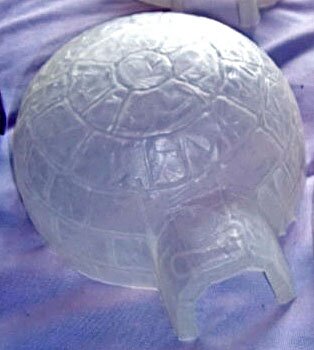
Of course, no set including Eskimos would be complete without igloos. I would suppose that not all "Indians" in Alaska lived in igloos, but the two go together like cowboys and saloons. PFPC magazine describes the Marx igloo as "frosty-colored" and Playset Magazine says it is "frosty opaque." It does have an icy look about it, and it does seem as if you can almost see through it. The igloo is about five inches in diameter. As with Marx' teepees, the igloos are down-sized and far too small for any Eskimo family to inhabit them. Three came with each set, but they sell for $20 to $30 today.
Accessories
Stockade outdoor accessory group
PL-351
This common accessory group -- sometimes called the Fort Apache group -- was included in Fort Dearborn, Western Ranch, and many Fort Apache play sets (see larger photos on Page 10 of the Wild West section). The pieces were made in hard plastic, in brown, tan and gray. An Alaska set could include items in all three colors.
The dip well and cooking fire are particularly fragile pieces. Each is a 2-piece item with a base and upper portion, and the pegs on the upper portion that are inserted into holes on the base are frequently found broken today. On the other hand, many are found with the two pieces glued together. The small powder barrels are hard to break and now seem to be the most readily available piece. The axes and anvils in stumps and log piles are also easily found today, because they also were included in other accessory groups.
Arctic Accessories
PL-914
The Alaska playset included 34 small hard plastic Arctic accessories that are divided into two color groups: beige and dark brown. The two groups -- as shown below -- could come in either of these colors, but the two groups were never the same color in one set. The number of each item included in the set is shown in parentheses.
These same accessories were used in the other Alaska and Arctic themed playsets, but came in bright blue and orange. As noted, most of the accessories shown below are re-issues, but are made from the original molds and therefore look exactly like the originals, except for the color.
Scientific and Specialty Accessories (PL-914)
Arctic Accessories (PL-914A and PL-914B)
Vehicles
Marx created molds for dog sleds and kayaks in all four of the Alaska and Arctic playsets. As shown below, these were nicely made with reasonable detail, though a 4-dog sled harness would have been more realistic. Even with the down-scaled harness, costly molds probably did not pay for themselves in the playsets' short 2-year run.
Each Alaska Play Set got two sleds and one kayak. The sleds in this set came in a reddish brown soft plastic, and the kayak was a brown soft plastic. The red sled pictured below, however, is original and probably came from a 1959 blister pack set titled Alaskan Polar Set that inclued two sleds, dogs, an igloo, a kayak, and eight Eskimos (and is pictured on page 19 of Playset Magazine Issue 51). The somewhat sturdy dog sled could hold 1) the female Eskimo rider shown above, 2) the sled pack shown above, or 3) anything else a kid might imagine would fit into a dog sled.
The brown kayak below is original, a rather nice piece. I have found that with a re-issue kayak, it is a bit tricky to slip the Eskimo oarsman into the hole provided, and it can best be done before joining the two kayak pieces. This process is easier with an original soft plastic kayak. The dogs also fit rather tightly into the sled harness, but even with a 50-year-old original harness, I was able to do so without separating the harness.
Re-issues of these items exist, as shown below in silver.
Terrain
As everyone knows, there is not much terrain up in Alaska other than snow drifts. Or at least that is what we kids believed in the 1950s, and that is how the Marx playset pictured it. The only terrain items in the set were dead trees. Having been to Alaska, I can guarantee you that there is plenty of large and small vegetation in Alaska and the rich soil there grows some of the biggest flowers I have ever seen in my life!
The Alaska Play Set included the dead tree and tree stumps that were found in many Wild West and military sets. The dead tree is about 4-3/4 inches tall, and the stumps are 1-1/2 inches and 1-1/4 inches. In the Alaska sets, they were a dark gray soft plastic. In other playsets these three items came in light gray (as below) and brown.
The playset that qualifies the figures and accessories below as a part of the Wild West is a set that featured the Alaskan frontier gold rush at the end of the 19th Century. In fact, the set was initially titled the Alaska Frontier Play Set, but by the time the set hit the market, the name had been changed to simply the Alaska Play Set (#3708). This was the fourth and final of the Alaskan sets and was an excellent example of Marx' economy in re-using existing molds: the set included the existing 54mm miners and trappers (see Page 3), Eskimos and accessories included in previous Alaskan playsets, and a Wild West townfront re-lithographed to match the Alaska environment.
Marx' other three playsets related to Alaska and the Arctic in 1958 and 1959 were
- an Arctic Explorer Play Set, the first set of this theme, released in 1958,
- the military-themed playset Defense Early Warning (D.E.W.) Arctic Satellite Base, and
- a similar playset titled International Geophysical Year (I.G.Y.) Arctic Satellite Base.
Of course, among collectors today such requirements are a moot point. We demand no such "playability" and instead are entranced with the sets' miniature dog sleds, howling wolves, frosty plastic igloos, and spear-fishing Eskimos.
I will admit that including Eskimos as a Wild West theme may seem a bit strange at first thought, but Eskimos were native American inhabitants. And that means they were Indians, though not quite the style of Indian that generally comes to one's mind regarding the Wild West. Also, Alaska is definitely in the western part of the United States. And there was a wild gold rush in Alaska during the final years of the 1890s, similar to the California gold rush 50 years earlier, that brought hundreds of rough and tough Americans to the frigid Arctic seeking that elusive yellow rock. Even Wyatt Earp and some of his friends from Tombstone spent a few years in Alaska! So it seems logical to me that these figures should be included here.
The thought to include these figures on this web site did not strike me until mid-2009, and even then I delayed creating this page until I obtained a reasonable number of the playset figures and accessories. I finally reached that goal at the 2011 West Coaster when I purchased the final figures in the Eskimo group from veteran seller Tom Sturgeon (teestoys@aol.com) and a complete set of Mexican-made re-issue accessories from Willie and Rosa of Forester Enterprises (www.willieandrosasclassicsoldiertoybox.com). These re-issues are in a dull silver color and what I would call a somewhat soft hard plastic (or perhaps a hard soft plastic); I hope that I can replace them with originals soon.
Because the Eskimo figure group, the Arctic animal group, and the Arctic accessories are included only in this one Wild West playset, I have chosen to show them on this separate page, as well as detail the complete contents of the Alaska Play Set. As noted in the text below, the Miner and Trapper figure group and the Stockade Outdoor Accessory Group are included in many Wild West playsets and are shown elsewhere in the Wild West section of this web site.
Articles on the Alaska Play Set are in PFPC Issue 4 and Playset Magazine Issue 51. The PFPC article also includes information on the Arctic Explorer set. The D.E.W. and I.G.Y. sets are featured in Playset Magazine Issue 32.
Eskimos
PL-912
Unlike, other Marx Wild West figure groups, this group of 54mm figures is made up of people going about their daily business in a fairly peaceable manner. Many of the 16 Eskimos (11 poses) are hunting or fishing, but none are shooting, clubbing, knifing, or involved in any other violent action. This may have contributed to the fact that the Alaska set was not a big seller and was in production for only in 1959. Similar to the kids of today, we kids of the 1950s and 1960s liked our playsets to be action-packed and extreme. This same group of figures was in the company's other three Alaska and Arctic sets.
The Alaska set included two figures of Poses 7 through 11 and one figure of all other poses. They were blue soft plastic in this set, but Playset Magazine reports that the I.G.Y. sets had yellow Eskimos. Therefore, I assume the yellow ones shown below came from an I.G.Y. set or perhaps in bagged sets of figures; I have included them in yellow just to add a little variety to the page.
Figures such as the "pulling dead seal" and "spear fishing" are difficult to find with unbroken ropes. Re-issues exist; the ones I have seen are easy to distinguish from the originals. My personal favorite has to be the fellow rowing his kayak, but only because I've always wanted to give that a try.
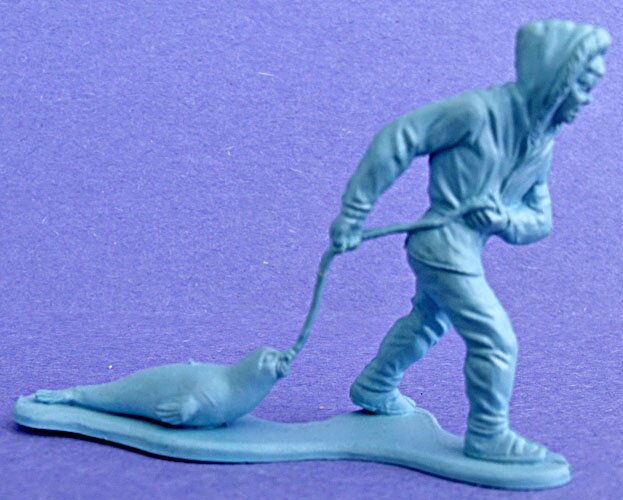 |
 |
| 1. Pulling dead seal (side and front views) |
|
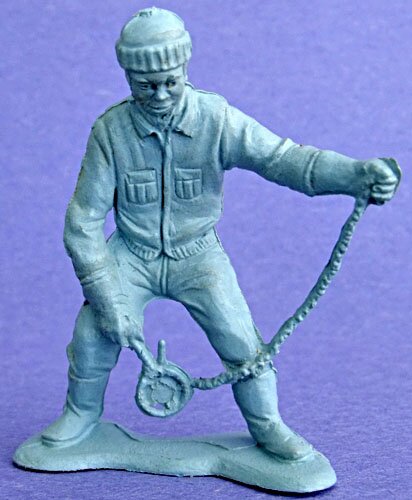 |
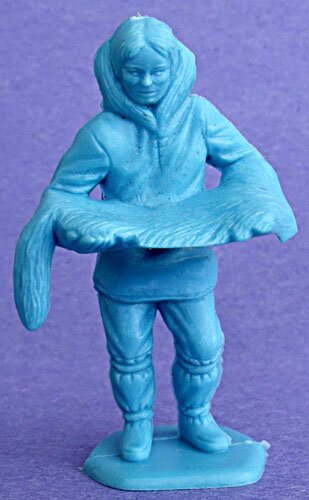 |
| 2. Setting trap |
3. Holding fur |
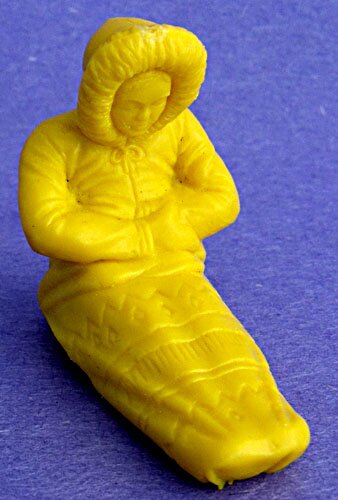 |
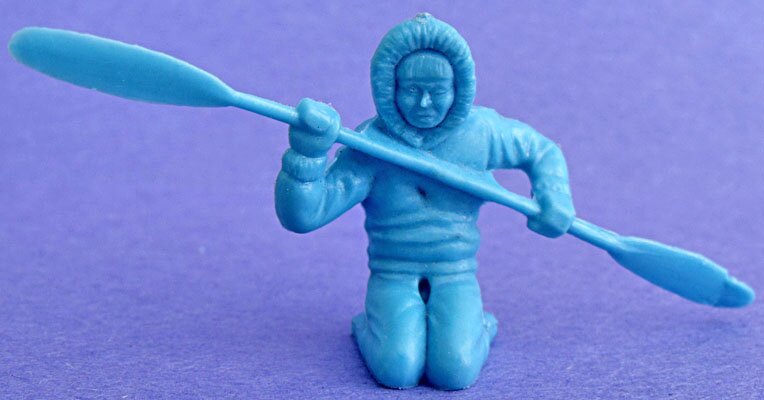 |
| 4. Woman seat, riding in sled Figure in Alaska playset was blue. |
5. Rowing kayak |
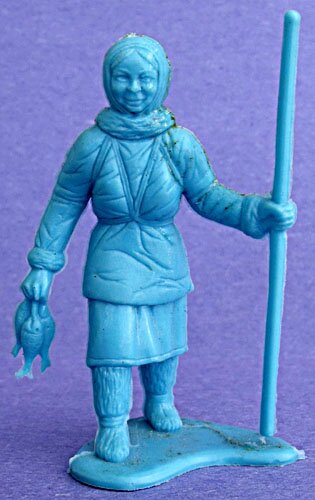 |
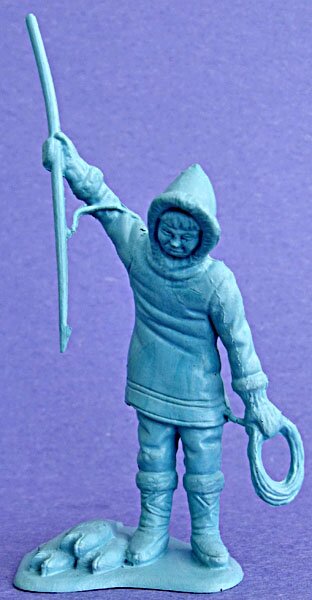 |
| 6. Woman with fish and pole |
7. Spear fishing |
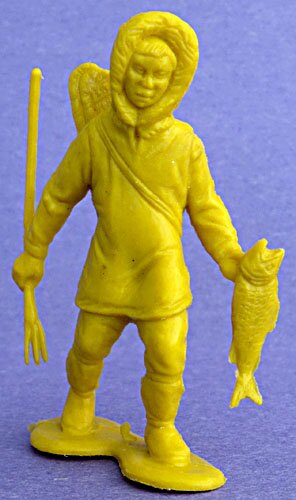 |
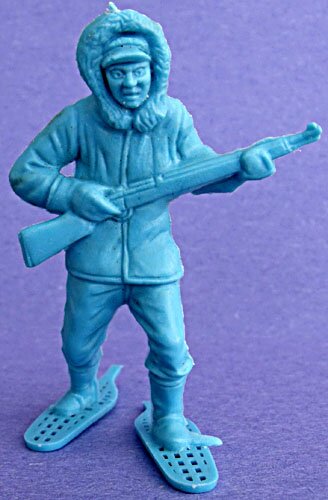 |
| 8. Walking with spear and fish Figure in Alaska playset was blue. |
9. In snowshoes with rifle |
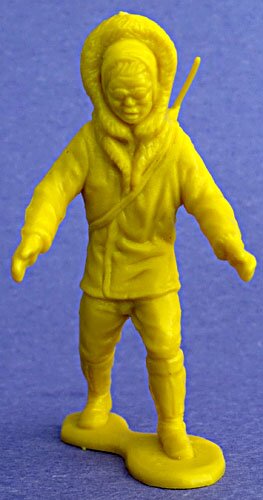 |
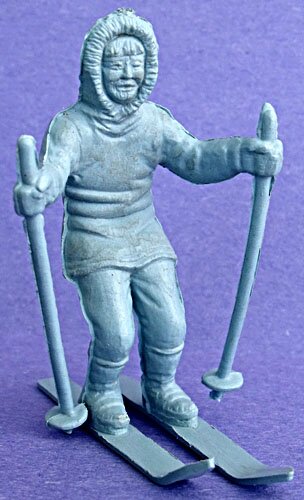 |
| 10. Sled driver, carrying rifle on back Figure in Alaska playset was blue. |
11. Skier, skis and poles molded onto figure |

54mm Miners and Trappers
PL-1014
The factor that confirms the Alaskan Play Set belongs to the Wild West category is the presence of the 54mm Miner and Trapper figure group. This group of figures (see larger photos on Page 3 of the Wild West Section) was used in a large number of Wild West playsets, including Roy Rogers, Gunsmoke, and Johnny Ringo. Marx created this group for its gold mine theme playsets, but eventually combined it with its 54mm cowboy figures in a huge 32-figure group. The mold was slightly revised even before that, as the "holding fur" pose (Pose 11 below) was replaced by a new miner figure for most Wild West sets. For the most part, these figures were produced either in gray or butterscotch. The group in the Alaska set was a gray soft plastic and included the 12 poses shown below with duplicates of Poses 3, 4, 5, and 6.
As noted on the 54mm figure page (Page 3), these figures are nicely detailed, and the group includes a good variety of poses involved in mining or trapping activities. Because the "holding fur" pose (Pose 11) was replaced in most Wild West sets, it is the most difficult pose to find. In fact, this pose in the gray color is unique to the Alaska set. Also, note that the tiny bag for the Pose 2 figure is virtually impossible to find today, as its size caused it to be quickly lost by us kids back in the late 1950s. The figure with an original bag (I have not seen the bag re-issued) should set you back $50 to $100, or perhaps even more.
 Marx' other three Alaska and Arctic playsets did not inlcude this group of figures. Instead, they had a group of 12 more modern Arctic figures that are commonly called the Arctic Explorers (including several U.S. military personnel). Like the Eskimos above, the Arctic Explorers appeared in no Marx playsets except the Alaska and Arctic sets. In general, these more modern figures would not fit in the Alaska gold rush theme, but the group does include a miner holding a lantern and pick that could easily have been added to the Miner and Trapper group (see photo at left).
Marx' other three Alaska and Arctic playsets did not inlcude this group of figures. Instead, they had a group of 12 more modern Arctic figures that are commonly called the Arctic Explorers (including several U.S. military personnel). Like the Eskimos above, the Arctic Explorers appeared in no Marx playsets except the Alaska and Arctic sets. In general, these more modern figures would not fit in the Alaska gold rush theme, but the group does include a miner holding a lantern and pick that could easily have been added to the Miner and Trapper group (see photo at left).Other than the small bag and the "holding fur" pose, these figures are easy to find and inexpensive in today's market. Re-issues exist in large numbers.
 |
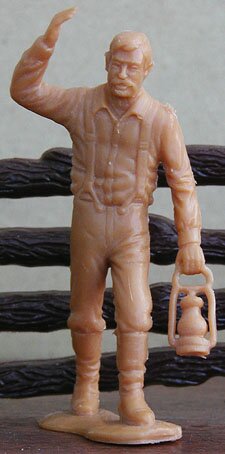 |
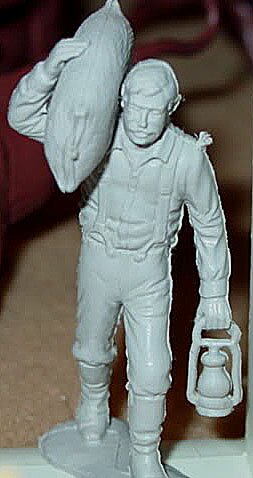 |
| 1. Walking with jacket and shovel | 2. Holding lantern and separate bag Separate bag not shown. Figure in Alaska set was gray. |
Miner in photo at left with bag Photo courtesy of David Schafer |
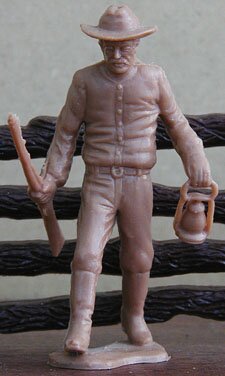 |
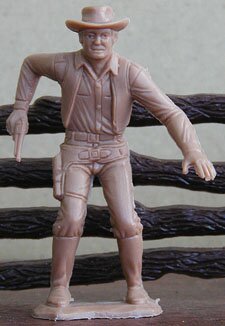 |
| 3. Walking with rifle and lantern Figure in Alaska set was gray. |
4. Drawing pistol Figure in Alaska set was gray. |
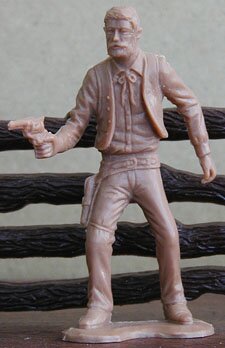 |
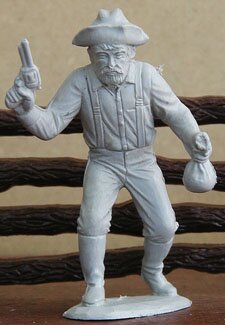 |
| 5. Sherriff, pistol in right hand Figure in Alaska set was gray. |
6. Old man with pistol and bag |
 |
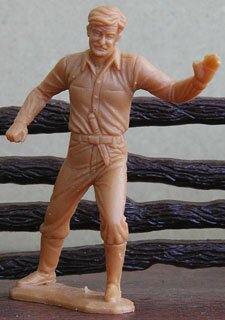 |
| 7. Fighting, hat on Figure in Alaska set was gray. |
8. Fighting, no hat Figure in Alaska set was gray. |
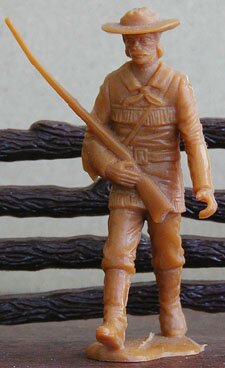 |
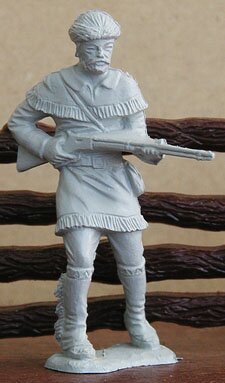 |
| 9. Walking, rifle cradled in right arm Figure in Alaska set was gray. |
10. Rifle held at waist |
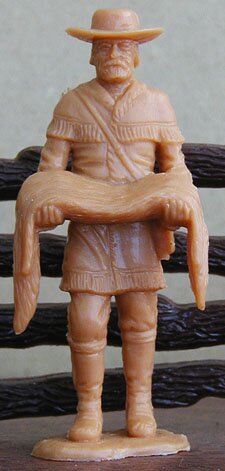 |
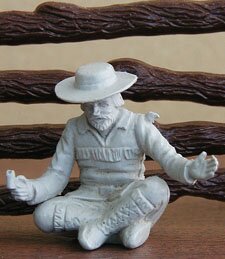 |
| 11. Standing, fur held in arms Figure in Alaska set was gray. |
12. Sitting on ground |

Animals
PL-911
Eighteen animals in 9 poses came with the Alaska set. Playset Magazine states they came in cream soft plastic in the Alaska Play Set; PFPC says that the various Alaska sets included the animals in both cream and gray. Compared to the hefty horses and cattle of the usual Wild West playsets, these animals are almost disappointingly small and fragile. The baby penguins are particularly twerpy-looking.
The figures are shown below in approximately the correct proportion to one another. The penguin in Pose 1 is about an inch high, and the sled dog is about two inches long. The bear is about 2-3/8 inches long and 1-1/4 inches tall. The number of figures for each pose is shown in parentheses. The "sleeping dog" pose could just as easily be "sleeping wolf."
 |
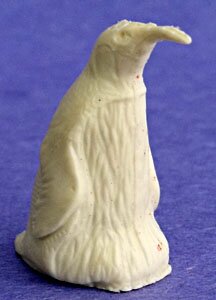 |
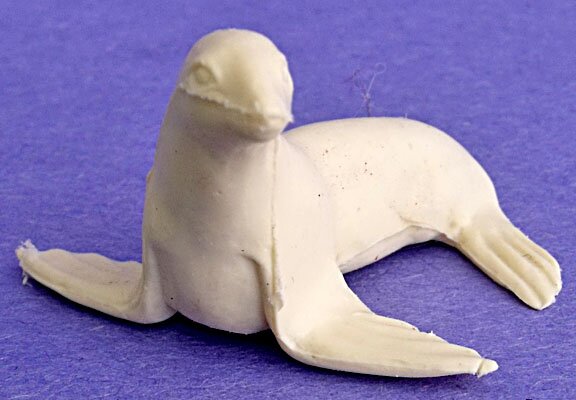 |
| 1. Penguin walking (4) | 2. Baby penguin (3) |
3. Seal (1) |
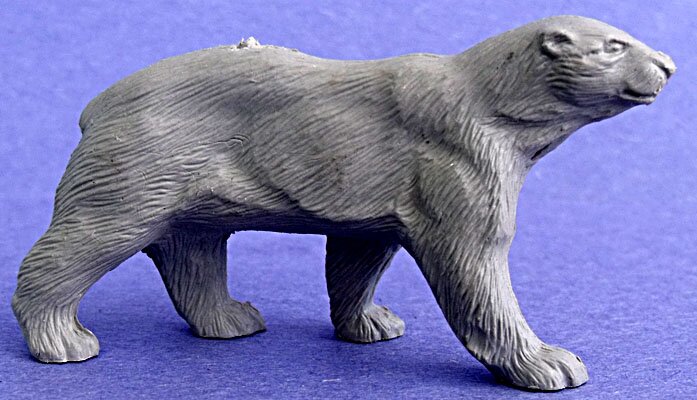 |
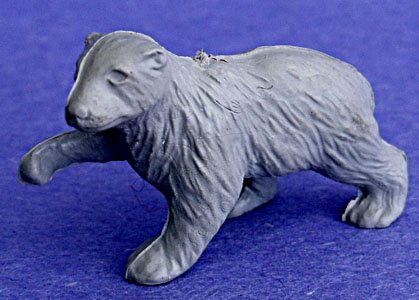 |
| 4. Polar bear (1) |
5. Baby polar bear (1) |
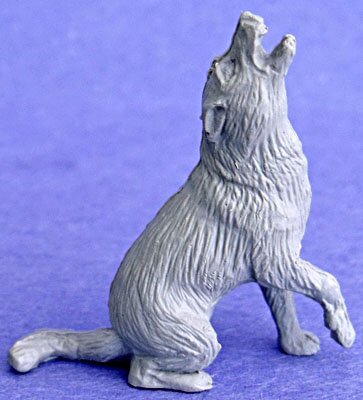 |
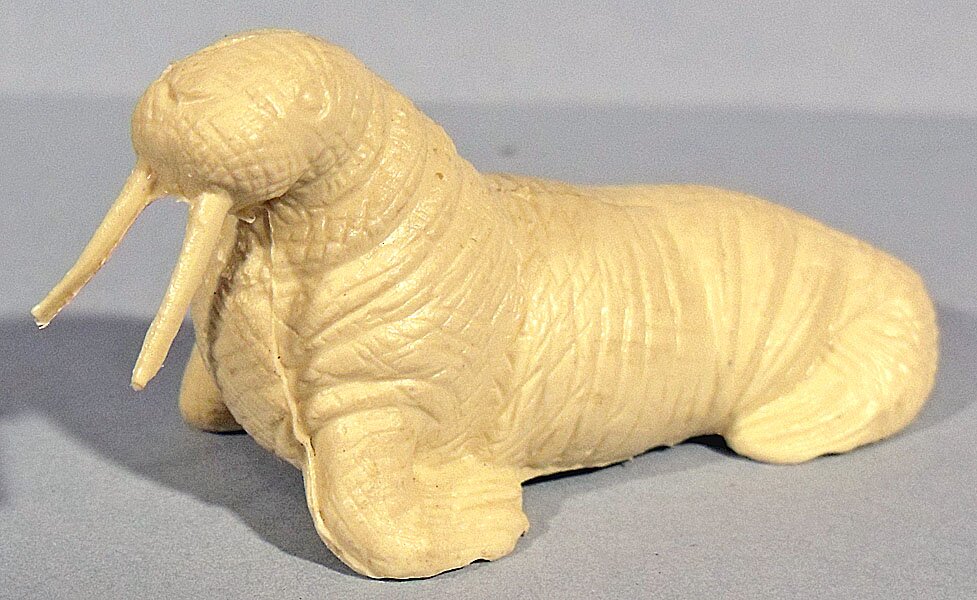 |
| 6. Howling wolf (1) |
7. Walrus (1) |
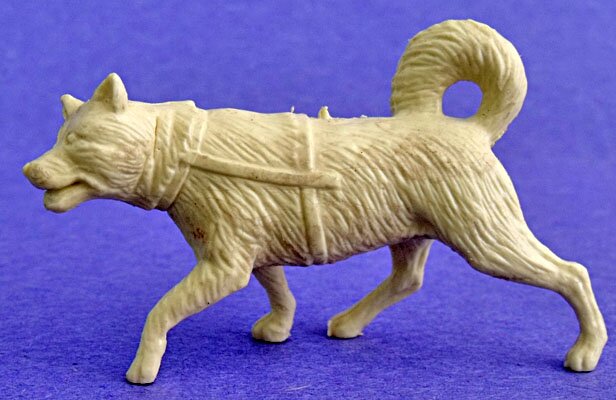 |
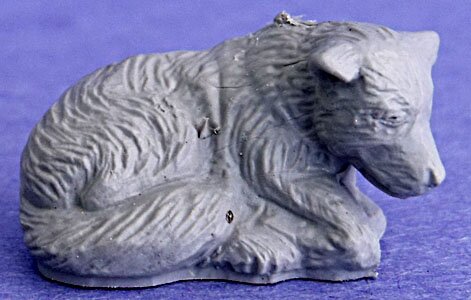 |
| 8. Sled dog (4) | 9. Sleeping dog (2) |

Buildings
The most popular and attractive piece in the Alaska Play Set has to be the townfront. This is the same metal building that Marx used for its Wells Fargo townfront in various other Wild West sets (see Page 9 of the Wild West section), which is downsized from the company's early jail and hotel townfronts. The outside lithography is different from the Wells Fargo version, with businesses aimed a bit more to the Alaska theme. The inside lithography remains the same. The building is only 4 inches deep with no floor or interior walls; overall, the building measures 20 inches wide and 5 inches high.
According to PFPC Issue 4, the Marx prototype and pre-sale advertising for the building included the Red Dog Saloon instead of the Golden Nugget and the Alaskan Bay Company rather than the Alaskan Trading Company. The reason for the change is not known. The townfront is not often seen and in good shape will cost $300 or so today.
Alaska Frontier Townfront
 |
| Front view |
 |
| Rear view |
Igloo

Of course, no set including Eskimos would be complete without igloos. I would suppose that not all "Indians" in Alaska lived in igloos, but the two go together like cowboys and saloons. PFPC magazine describes the Marx igloo as "frosty-colored" and Playset Magazine says it is "frosty opaque." It does have an icy look about it, and it does seem as if you can almost see through it. The igloo is about five inches in diameter. As with Marx' teepees, the igloos are down-sized and far too small for any Eskimo family to inhabit them. Three came with each set, but they sell for $20 to $30 today.
Accessories
Stockade outdoor accessory group
PL-351
This common accessory group -- sometimes called the Fort Apache group -- was included in Fort Dearborn, Western Ranch, and many Fort Apache play sets (see larger photos on Page 10 of the Wild West section). The pieces were made in hard plastic, in brown, tan and gray. An Alaska set could include items in all three colors.
The dip well and cooking fire are particularly fragile pieces. Each is a 2-piece item with a base and upper portion, and the pegs on the upper portion that are inserted into holes on the base are frequently found broken today. On the other hand, many are found with the two pieces glued together. The small powder barrels are hard to break and now seem to be the most readily available piece. The axes and anvils in stumps and log piles are also easily found today, because they also were included in other accessory groups.
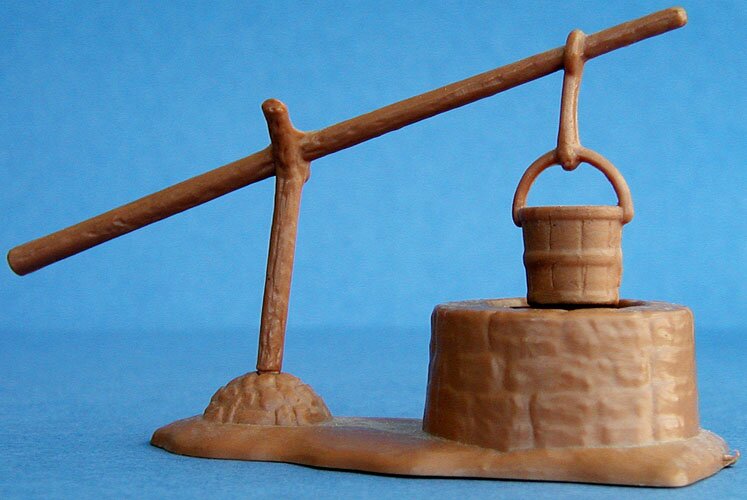 |
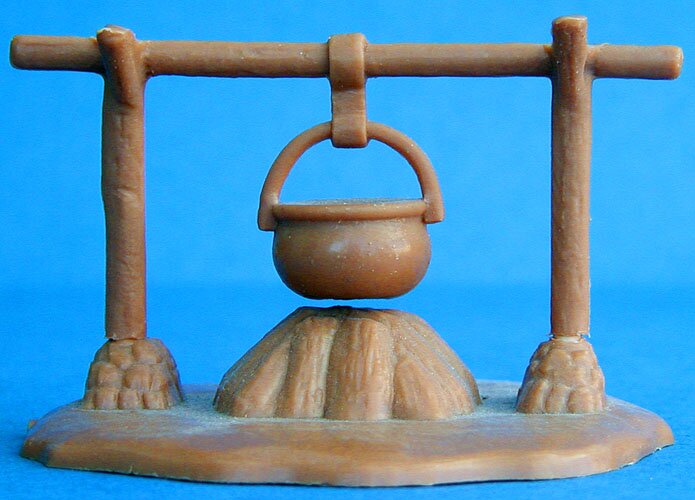 |
| 1. 2-piece dip well | 2. 2-piece pot hanging over fire |
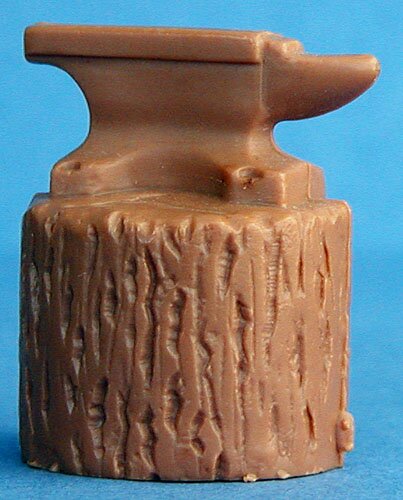 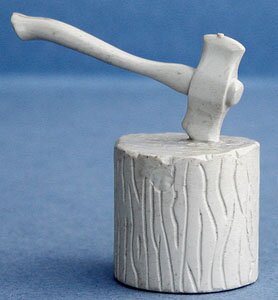 |
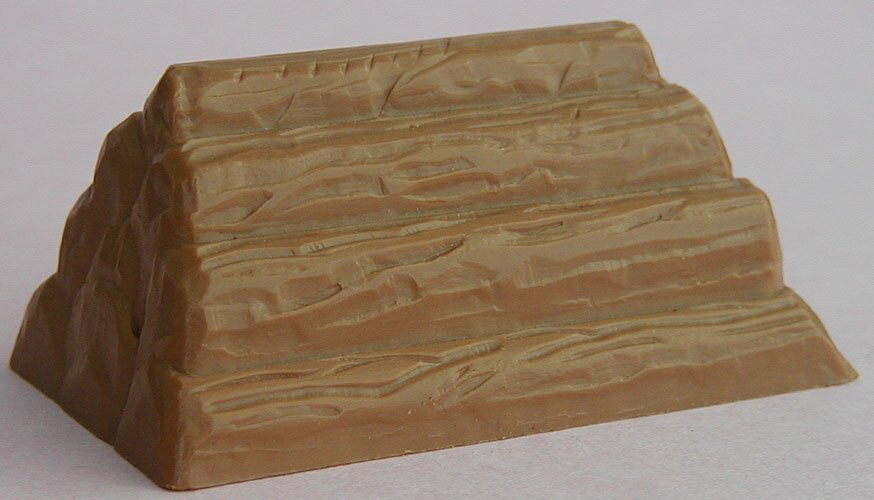 |
| 3. Anvil on stump 4. Axe on stump |
5. Log pile |
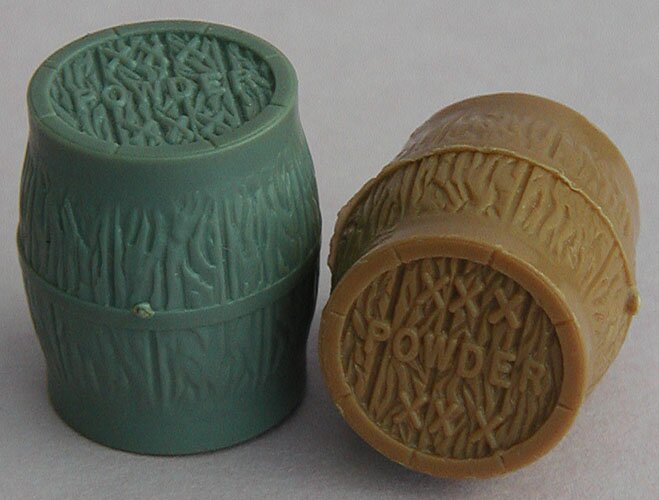 |
 |
| 7. Powder barrels (2) Closed top with XXX Powder XXX written on it. |
7. Butter churn |
Arctic Accessories
PL-914
The Alaska playset included 34 small hard plastic Arctic accessories that are divided into two color groups: beige and dark brown. The two groups -- as shown below -- could come in either of these colors, but the two groups were never the same color in one set. The number of each item included in the set is shown in parentheses.
These same accessories were used in the other Alaska and Arctic themed playsets, but came in bright blue and orange. As noted, most of the accessories shown below are re-issues, but are made from the original molds and therefore look exactly like the originals, except for the color.
Scientific and Specialty Accessories (PL-914)
 |
 |
| 1. Lean-to (from front and back) (1) Re-issue item |
|
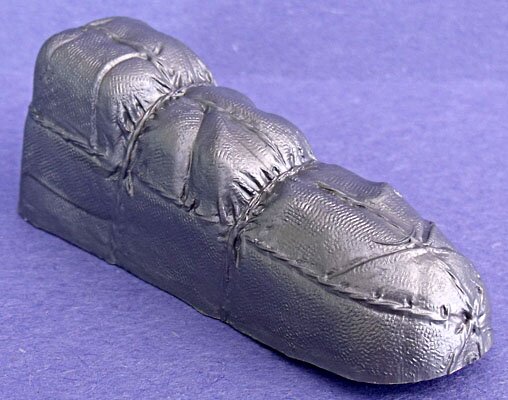 |
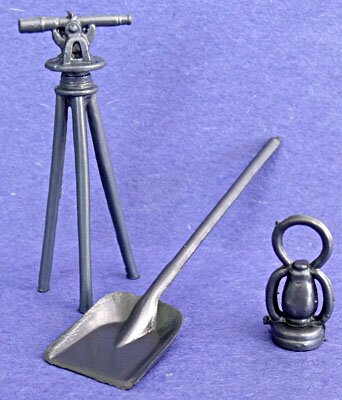 |
| 6. Load for sled (1) Re-issued item |
3. Sextant (1) 4. Shovel (1) 5. Lantern (2) Re-issued items. Lantern also used with Wild West wagons. |
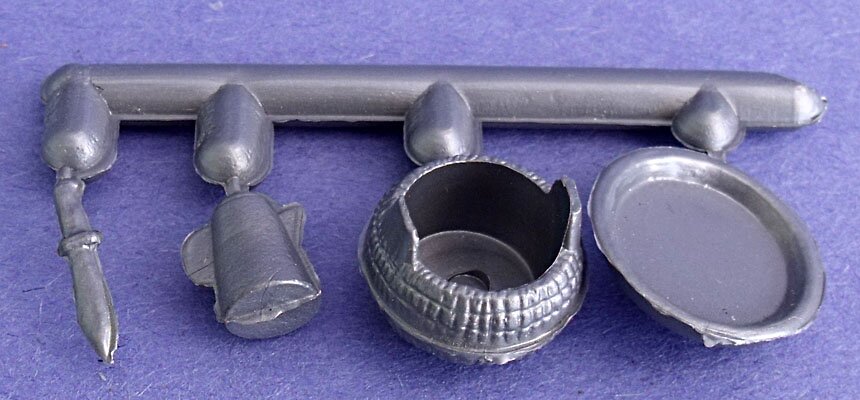 |
 |
| Small sprue (1): 2. Knife 3. Coffee pot 4. Basket 5. Plate Re-issued items |
5. Barrel (2) Re-issued item |
Arctic Accessories (PL-914A and PL-914B)
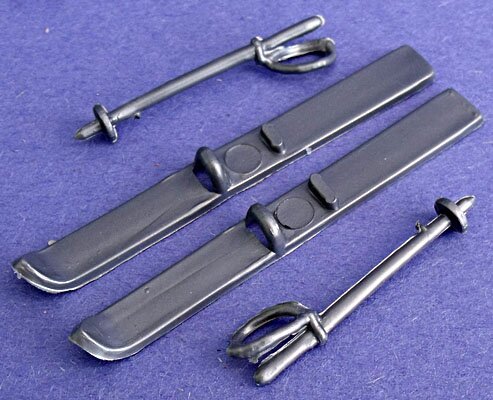 |
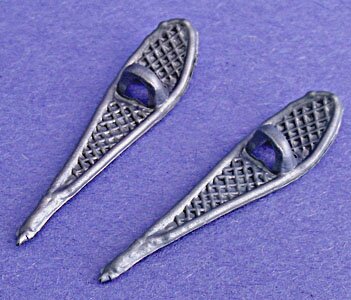 |
| 1. Skis (4) 2. Ski poles (4) Re-issue items |
3. Snowshoes (2) Re-issue item. |
 |
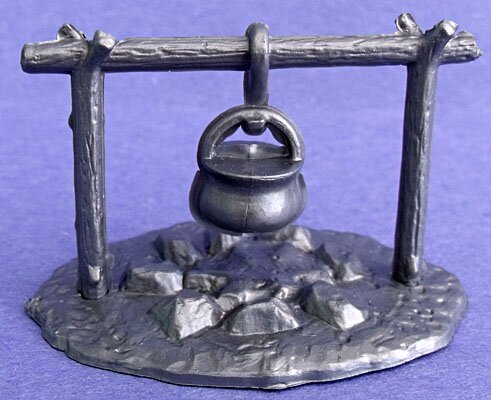 |
| 4. Bedroll (1) 5. Frying pan (1) 6. Rifle (3) Re-issue items. Bedroll also used with Wild West wagons. |
7. 2-piece pot over fire (1) Re-issue item. |
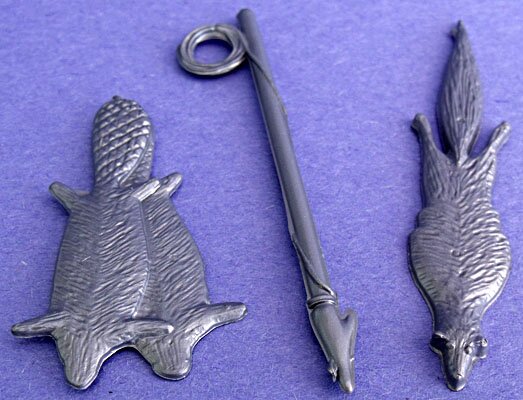 |
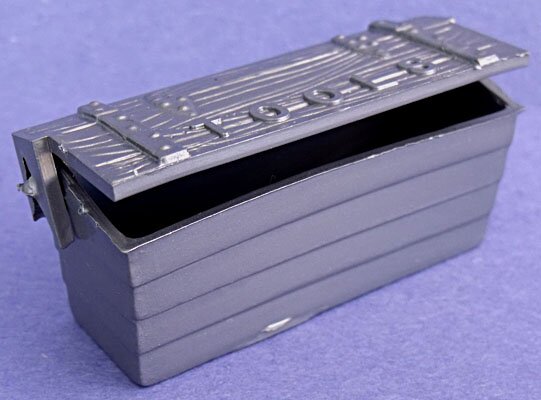 |
| 8. Two beaver hides (1) 9. Harpoon (1) 10. One beaver hide (1) Re-issue items |
11. 2-piece tool box (1) Re-issue item. Also used in construction playsets. |
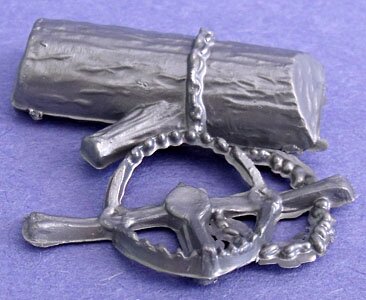 |
 |
| 11. Trap chained to log (1) Re-issue item. Item has extensive plastic flashing from mold. |
12. Camp fire (unlit) (1) Re-issue item. |
Vehicles
Marx created molds for dog sleds and kayaks in all four of the Alaska and Arctic playsets. As shown below, these were nicely made with reasonable detail, though a 4-dog sled harness would have been more realistic. Even with the down-scaled harness, costly molds probably did not pay for themselves in the playsets' short 2-year run.
Each Alaska Play Set got two sleds and one kayak. The sleds in this set came in a reddish brown soft plastic, and the kayak was a brown soft plastic. The red sled pictured below, however, is original and probably came from a 1959 blister pack set titled Alaskan Polar Set that inclued two sleds, dogs, an igloo, a kayak, and eight Eskimos (and is pictured on page 19 of Playset Magazine Issue 51). The somewhat sturdy dog sled could hold 1) the female Eskimo rider shown above, 2) the sled pack shown above, or 3) anything else a kid might imagine would fit into a dog sled.
The brown kayak below is original, a rather nice piece. I have found that with a re-issue kayak, it is a bit tricky to slip the Eskimo oarsman into the hole provided, and it can best be done before joining the two kayak pieces. This process is easier with an original soft plastic kayak. The dogs also fit rather tightly into the sled harness, but even with a 50-year-old original harness, I was able to do so without separating the harness.
Re-issues of these items exist, as shown below in silver.
 |
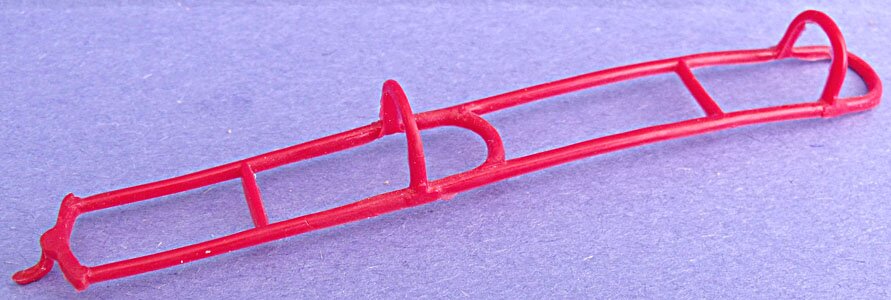 |
| 1. Dog Sled |
2. Harness for dog sled |
 |
|
| Dog sled with dogs in harness |
|
 |
|
| Dog sled ready to go |
|
 |
|
| Re-issue dog sled with harness |
|
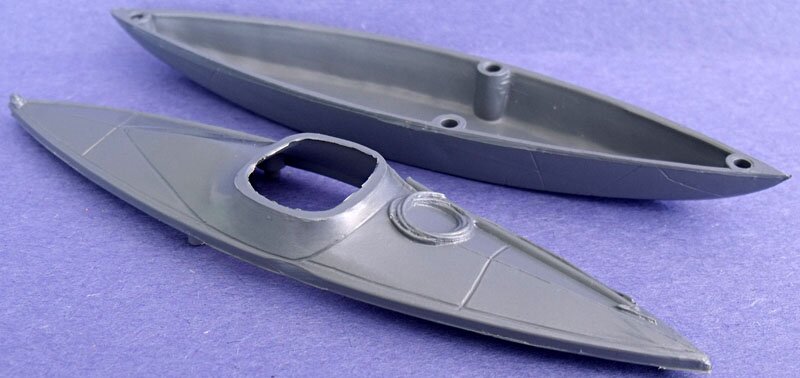 |
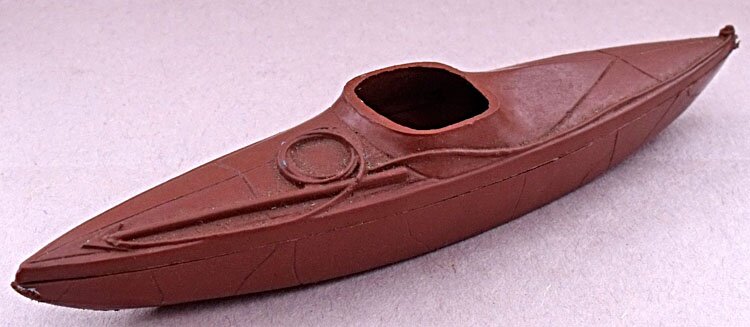 |
| 3. 2-piece kayak Re-issue item |
3. Kayak assembled Original kayak |
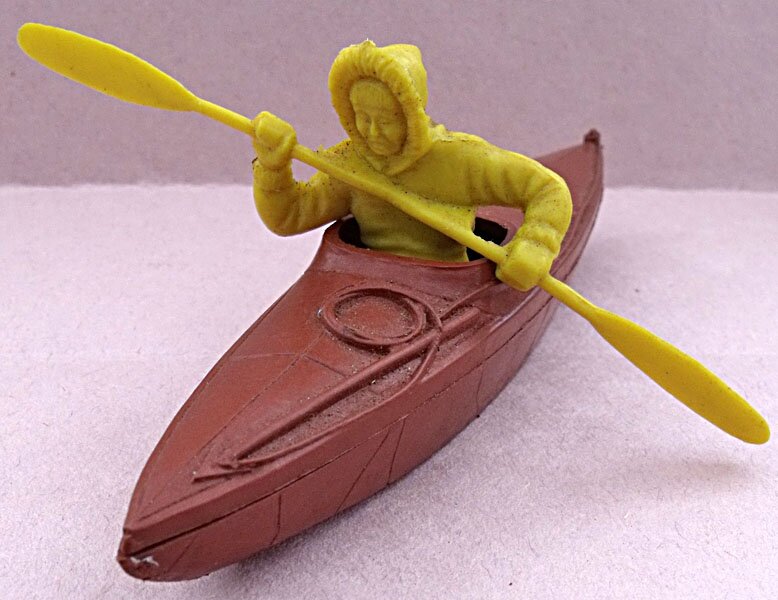 |
|
| Kayak with rider | |
Terrain
As everyone knows, there is not much terrain up in Alaska other than snow drifts. Or at least that is what we kids believed in the 1950s, and that is how the Marx playset pictured it. The only terrain items in the set were dead trees. Having been to Alaska, I can guarantee you that there is plenty of large and small vegetation in Alaska and the rich soil there grows some of the biggest flowers I have ever seen in my life!
The Alaska Play Set included the dead tree and tree stumps that were found in many Wild West and military sets. The dead tree is about 4-3/4 inches tall, and the stumps are 1-1/2 inches and 1-1/4 inches. In the Alaska sets, they were a dark gray soft plastic. In other playsets these three items came in light gray (as below) and brown.
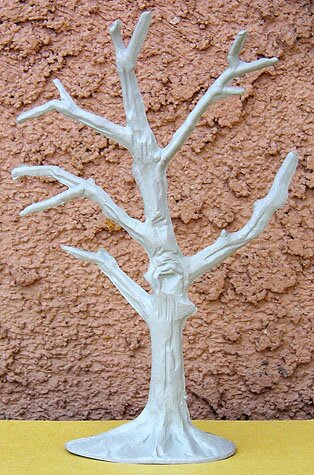 |
 |
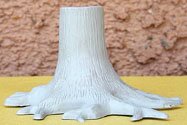 |
| Dead tree (PL-332 and PL-332A) |
Large stump (PL-332A) |
Small stump (PL-332A) |